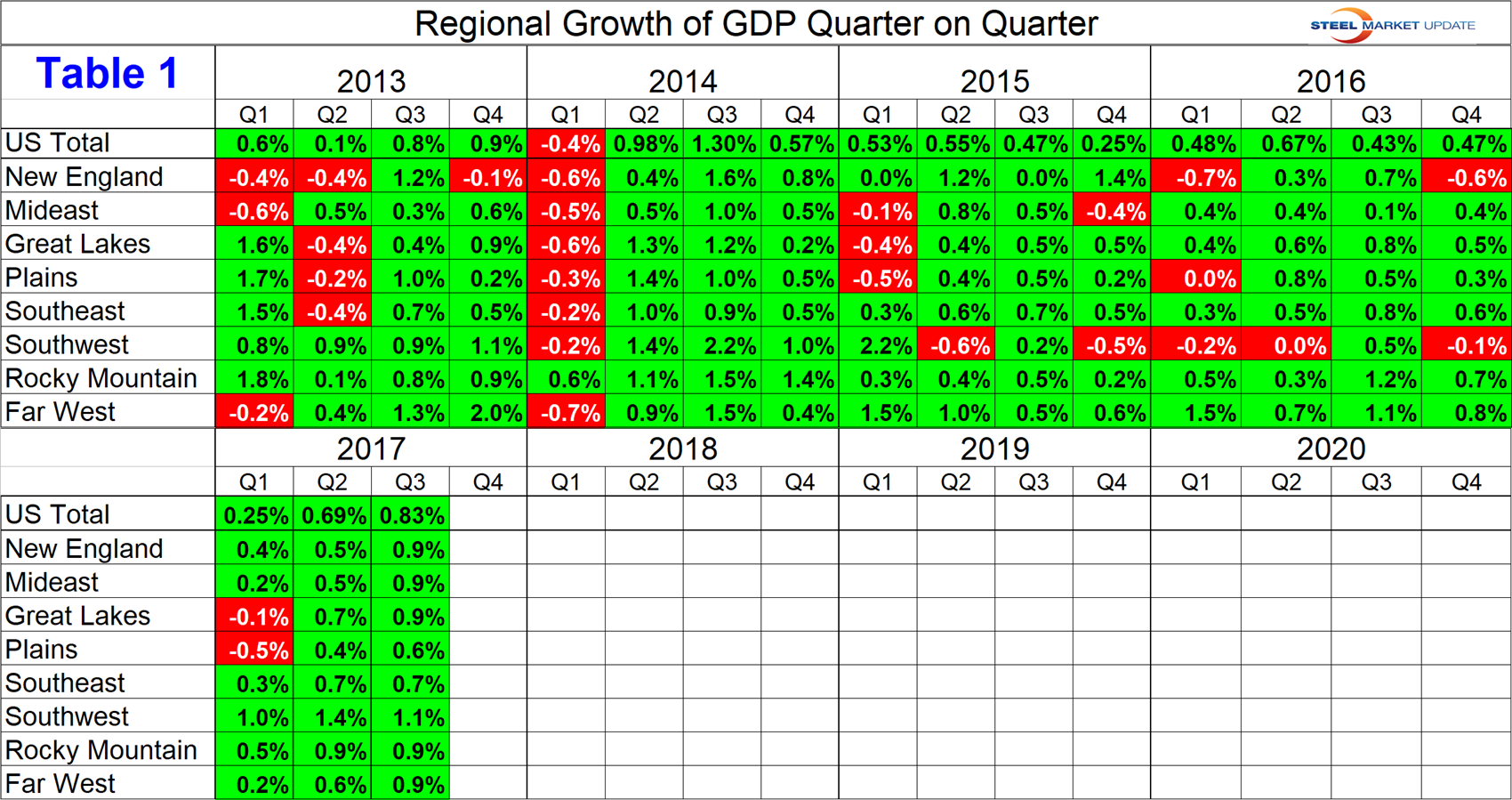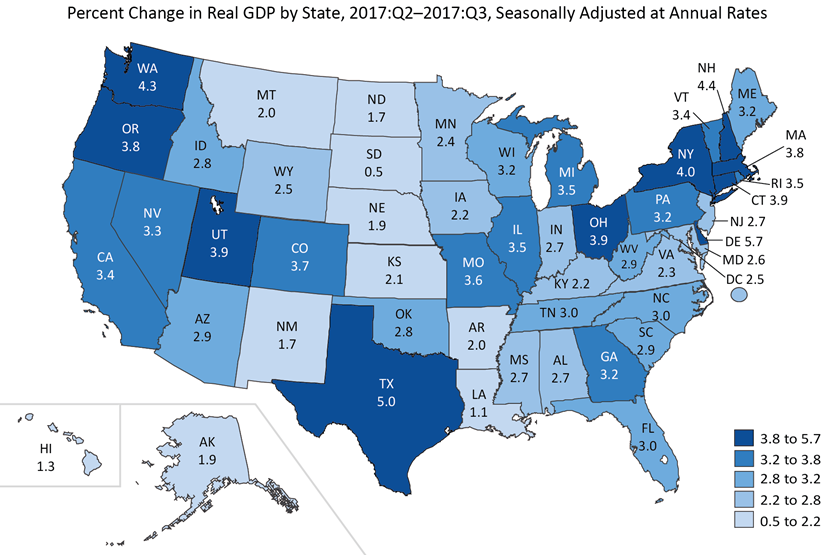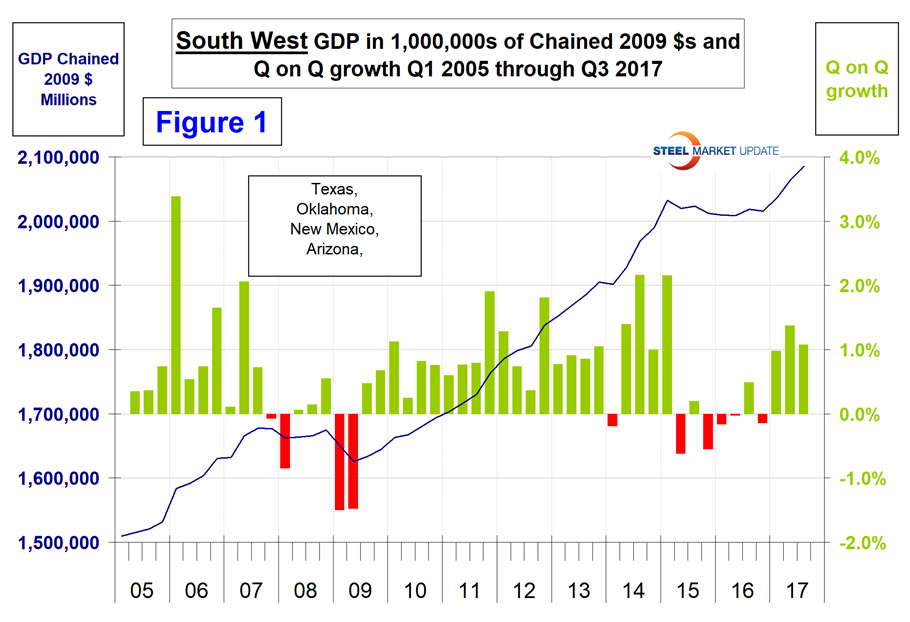Economy

U.S GDP Grew in Every Region in Q2, Q3 2017
Written by Peter Wright
February 21, 2018
U.S. gross domestic product grew in every region of the country in last year’s second and third quarters, according to Bureau of Economic Analysis data.
The BEA introduced a new data set for GDP by state and region in 2014 and backdated it to Q1 2005. This week, the data was updated through Q3 2017. Even though this might be considered historically “old,” we think it’s worth reporting because it’s the foundation for where we are now.
The data is published quarterly and is reported in chained 2009 dollars seasonally adjusted. Steel Market Update analyzes the data and reports to subscribers quarterly by region. Data and graphs for an individual state are available on request. Table 1 shows the growth of regional GDP in chained 2009 dollars quarter on quarter. (These numbers are not annualized as is the case for published reports of the growth of national GDP.) In the second and third quarters of 2017, every region had positive growth.
The BEA produces a map of the United States showing quarter-over-quarter growth by state within each region. Included here is the map for Q3 2017 extracted from the BEA website to enable readers to see how their individual states progressed between Q2 2017 and Q3 2017. Texas had the highest growth rate at 5.0 percent and South Dakota the lowest at 0.5 percent.
Regions as defined by the BEA are as follows:
New England: Connecticut, Maine, Massachusetts, New Hampshire, Rhode Island, Vermont.
Mideast: Delaware, DC, Maryland, New Jersey, New York, Pennsylvania.
Great Lakes: Illinois, Indiana, Michigan, Ohio, Wisconsin.
Plains: Iowa, Kansas, Minnesota, Missouri, Nebraska, North Dakota, South Dakota.
South East: Alabama, Arkansas, Florida, Georgia, Kentucky, Louisiana, Mississippi, North Carolina, South Carolina, Tennessee, Virginia, West Virginia.
South West: Arizona, New Mexico, Oklahoma, Texas.
Rocky Mountain: Colorado, Idaho, Montana, Utah, Wyoming.
Far West: Alaska, California, Hawaii, Nevada, Oregon, Washington.
In the third quarter of 2017, the South West had the highest growth rate at 1.1 percent. The Plains had the lowest growth rate at 0.6 percent.
Once per quarter, SMU publishes a report of regional job creation to help subscribers compare their own corporate results with those of other companies in their region. Figure 1 shows subscribers an example of the graphs available on request for individual regions and states. This case shows the results for the South West region, which suffered belatedly from the oil price collapse in third-quarter 2014. GDP in the South West didn’t respond until second-quarter 2015, and once oil got back above $50 per barrel the economy in the region began to roll again.
The U.S. values in this report are different and lower that the official report published in National Income and Product Account (NIPA) reports partly because the GDP-by-state numbers exclude federal military and civilian activity located overseas (because it cannot be attributed to a particular state). In addition, the official quarterly report of national GDP is annualized, which increases the value by a factor of four.

Peter Wright
Read more from Peter WrightLatest in Economy

AISI: Raw steel production ticks up near recent high
The volume of raw steel produced by US mills inched higher last week, according to the American Iron and Steel Institute (AISI). After steadily increasing in April and May, domestic mill output stabilized in early June and has remained historically strong since.

Steel groups welcome passage of budget bill
Steel trade groups praised the passage of the Big Beautiful Bill (BBB) in Congress on Thursday.

Industry groups praise Senate for passing tax and budget bill
The Steel Manufacturers Association and the American Iron and Steel Institute applauded the tax provisions included in the Senate's tax and budget reconciliation bill.

Chicago PMI dips 0.1 points in June
The Chicago Purchasing Managers Index (PMI) slipped 0.1 points to 40.4 points, in June.

Multi-family pullback drives housing starts to 5-year low in May
US housing starts tumbled in May to a five-year low, according to figures recently released by the US Census Bureau.



